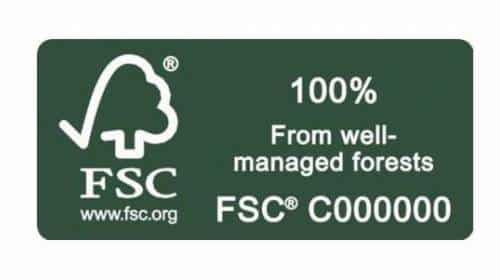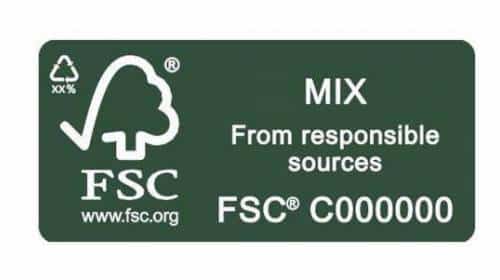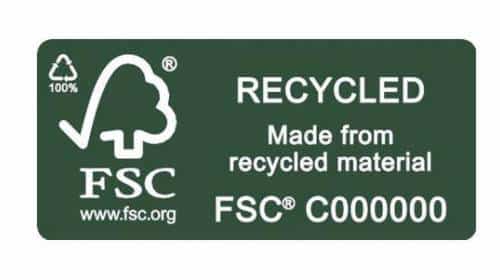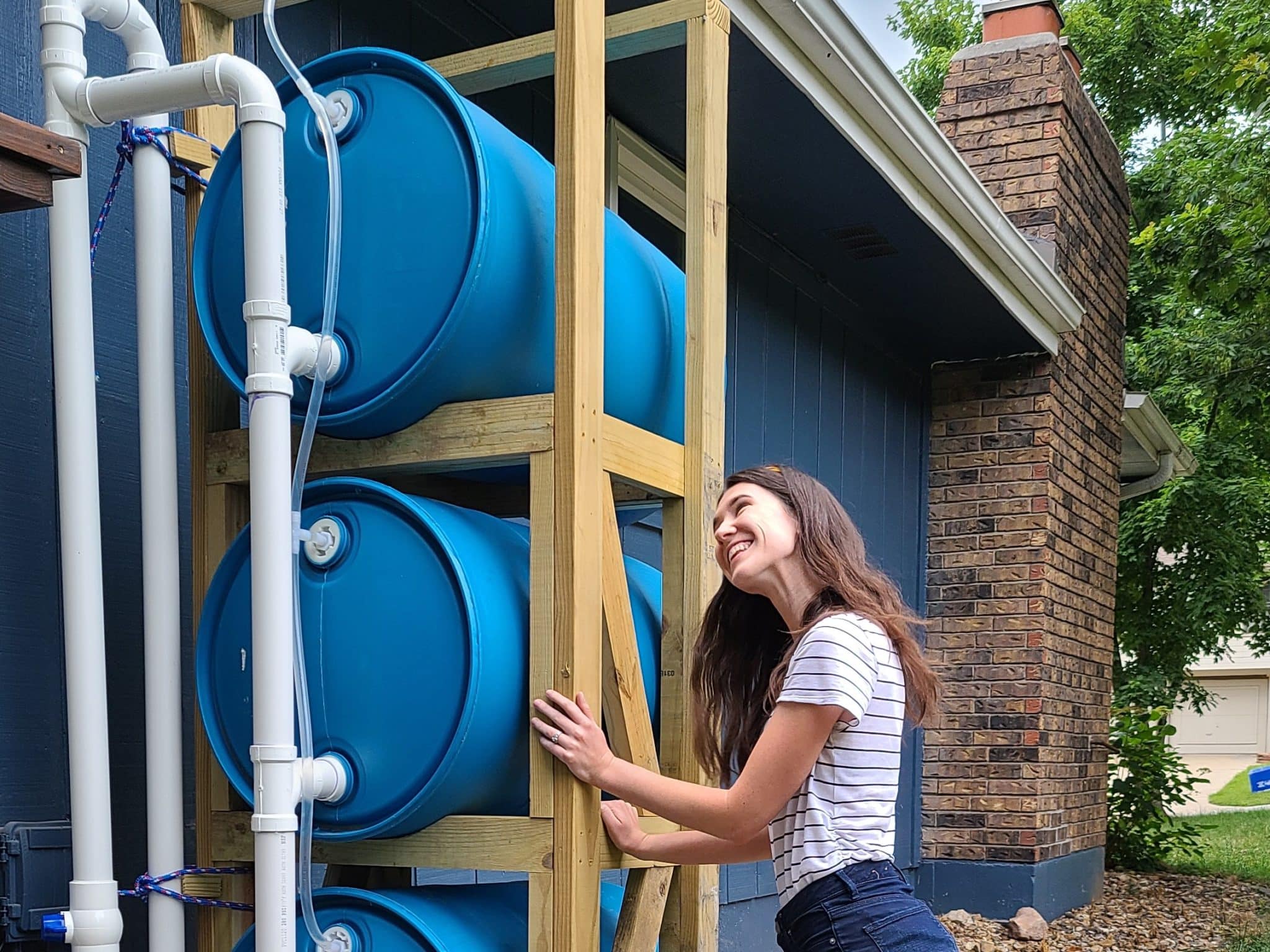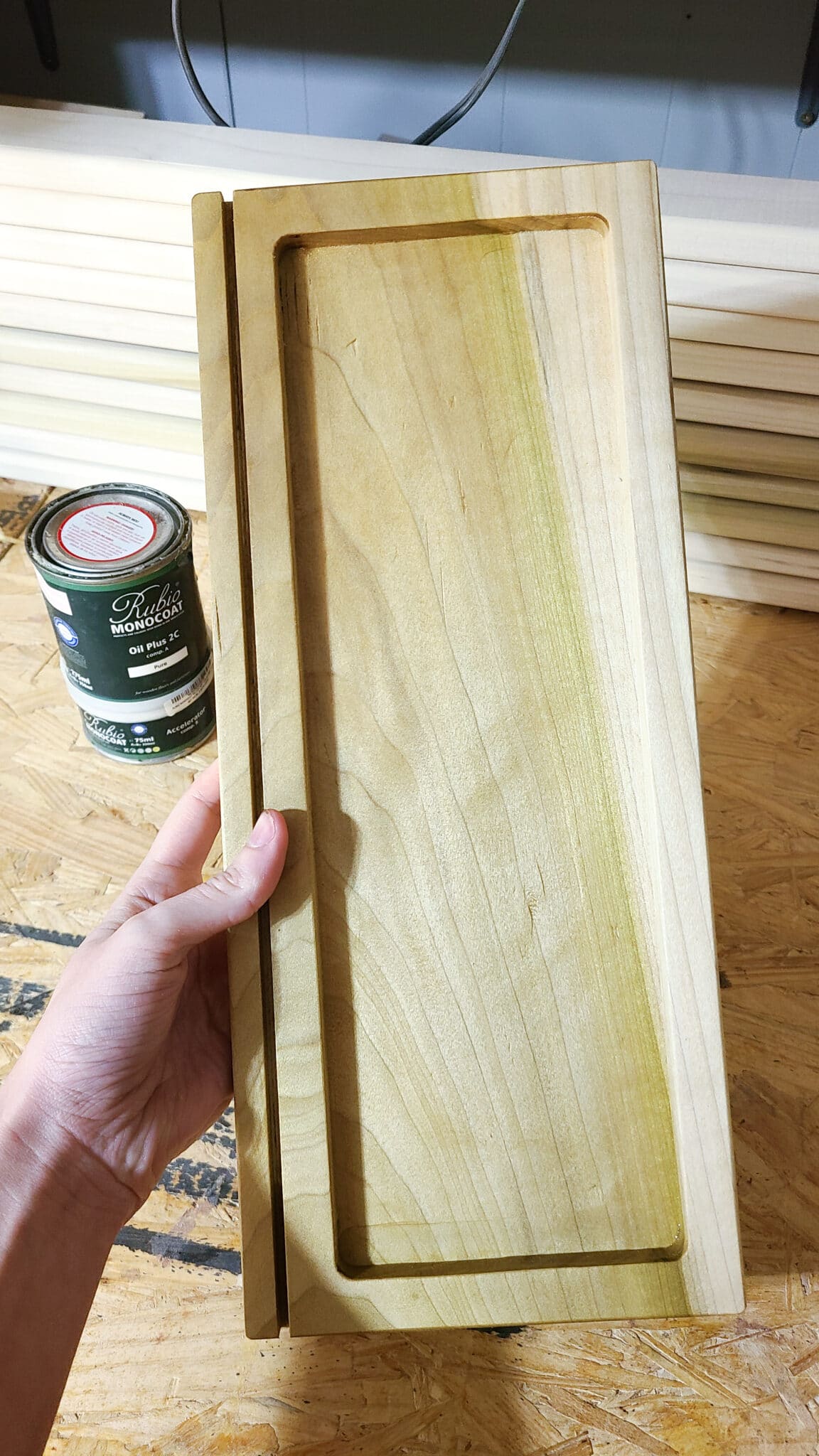Best Eco-friendly Wood Types For Sustainable DIY Projects
Are you a DIYer or a woodworker trying to do projects in a more eco-friendly way? Wood is a beautiful renewable resource, but there are a lot of factors that play into how sustainable different wood species are. In this post, we’ll cover the best eco-friendly wood types for your next sustainable DIY project!

Disclaimer: This post includes affiliate links, and I will earn a commission if you purchase through these links. No additional cost for you. Read about our privacy policy.
In the realm of do-it-yourself (DIY) and woodworking projects, the choice of materials plays a critical role not only in the outcome of the project but also in its environmental impact. As awareness of sustainability grows, more and more DIY enthusiasts and woodworkers like us are turning to eco-friendly wood types for their projects.
One of our goals is to leave a little footprint on our environment, which leads to a lot of DIY projects. However, like anything, we try to consider the impact of the products we use and make intentional choices.
In this post, we’ll dive into the importance of eco-friendly wood in projects, explore the benefits of using sustainable wood, and provide an overview of the top eco-friendly wood types that are perfect for your next DIY or woodworking project.
Quick Reference List For Eco-friendly Wood Types
Based on our research and understanding, here’s a quick reference list of the top eco-friendly woods we’ve used and/or seen available to DIYers and woodworkers. Read on for more details and information, and feel free to skip ahead to the list by clicking the species below.
Common Wood Types With Potential
The Importance of Eco-friendly Wood in DIY Projects
It’s not just about crafting something beautiful or functional; it’s also about making mindful choices that positively impact the environment. This is where the importance of eco-friendly wood types in DIY projects comes into play.
When starting a DIY project, it’s essential to consider the environmental impact of the materials you choose. Traditional wood harvesting methods can contribute to deforestation, habitat destruction, and soil erosion. Moreover, they can impact social issues with indigenous populations and local communities living around forested areas.
Eco-friendly wood is sourced from responsibly managed forests or reclaimed from old structures, reducing the demand for virgin timber. By supporting sustainable forestry practices, DIY enthusiasts and woodworkers can contribute to the conservation of biodiversity and the protection of endangered ecosystems.
Furthermore, sustainable wood is often free from harmful chemicals and toxins commonly found in treated lumber. This makes it a safer choice for both the environment and your health, especially if you’ll be working on indoor projects or items that come into contact with food or water.
By opting for eco-friendly wood types, you can minimize your carbon footprint, help preserve our planet’s precious resources, and support making a positive impact.
The Benefits of Using Sustainable Wood
Using sustainable wood in DIY projects offers a multitude of benefits, both for the environment and for the quality of your creations. One of the primary advantages is the positive impact on forest ecosystems. Sustainable forestry practices promote the following:
- Biodiversity
- Soil Health
- Watershed Protection
- Ensure that forests remain vibrant and resilient for generations to come
Related – Eco-friendly Building Materials & Products: A Guide For DIYers & Homeowners
What Determines The Sustainability of Wood Types?
Now you might be asking yourself, what even determines the sustainability of wood species? Eco-friendly and sustainable wood refers to wood that is sourced and harvested in an environmentally responsible and socially conscious manner. Life cycle analyses and certifications can help us determine whether the wood meets these standards.
Life Cycles
Life cycle assessments are a technique that’s used to assess environmental aspects and potential impacts associated with a product and/or service.
There are typically five stages of the life cycle for wood and lumber used for DIY and woodworking projects:
- Growing of the wood
- Manufacturing/processing of the wood into boards
- Transportation of the wood
- Usage of the wood
- End-of-life of the wood
Understanding each stage for different types of wood helps assess the level of sustainability in an analytical way.
Threatened & Endangered Wood Species
Life cycle analyses help determine whether harvesting the tree will contribute to destroying or endangering the species in habitats and whether the species can reproduce at a sustainable rate compared to the current harvesting rate.
The Convention on International Trade of Endangered Species (CITES) is an international agreement that evaluates and adds/removes wood species to a three-tiered list of endangered species every year. There is also the International Union for Conservation of Nature (IUCN), which provides a “Red List” related to species endangerment and risk of extinction.
Wood Database provides a great shortened list of specific threatened woods used as lumber from both CITES and IUCN, and it’s the quick easy list we refer to.
Some of the well-known wood furniture species like Mahogany are actually considered vulnerable or endangered according to IUCN, meaning that many Mahogany species are facing a high risk of extinction in the medium-term to near future. Just being aware of what commonly available wood species are on the endangered list can help you look at and choose a better alternative for your next project.
FSC Certifications
Forest Stewardship Council (FSC) sets worldwide standards for responsible forestry and provides product certifications. FSC-certified wood means that the wood product comes from a sustainably managed forest that is environmentally appropriate, socially beneficial, and economically viable. The companies must maintain/improve high conservation values, uphold good social and economic well-being for workers, establish management plans, and more.
An FSC-certified label on a product like wood verifies sustainable sourcing from forest to consumer and helps ensure you are supporting sustainable forestry practices.
Related – The Ultimate Guide to Sustainable Home Improvements For Eco-conscious DIYers
Eco-friendly & Sustainability Factors Vary
Typically the best choices for wood species are domestic lumber that is sustainably managed and harvested or FSC-certified. It’s the least traveled and the certification lets you know it’s considered the environment.
But like many things, there is wide variability with sustainability factors and you have to consider what’s most important to you. There is not truly a “wrong’ answer or choice. It’s just being knowledgeable and aware of the impact of different wood types and then making an intentional choice that both works for your project and budget while also doing your part to reduce environmental impact.

Factors that can play into the overall impact are:
- Project type – you may need a specific wood type over another (interior vs exterior project), softness vs hardness levels of wood needed.
- Project budget – how much is feasible to spend, the intended lifespan of the project.
- What’s available – local species depending on where you live, shipping something vs. using what’s local.
Overall, there are a lot of factors that determine sustainability and you should consider them when starting your project. With our knowledge, we’ve put together a list of the top eco-friendly wood types.
The Top Eco-friendly Wood Types
Now that we’ve covered the importance and benefits of using eco-friendly wood in DIY projects, let’s explore some of the top wood types that align with sustainable principles. These are the woods we’ve used/seen commonly available for people to access at home improvement stores and lumber yards. From bamboo to red grandis eucalyptus, there’s a diverse array of options to suit every project and preference.
Reclaimed Wood & Scraps
While it’s not a specific species, reclaimed wood offers a sustainable solution for DIY enthusiasts seeking character and history in their projects. Salvaged from old barns, warehouses, or even your own home, reclaimed wood adds a charm and story to any creation. It also extends the lifespan of a wood species even if it’s not a typical eco-friendly wood type. Using what you have and repurposing it can be one of the most sustainable choices.
Tips – Make sure the wood has been kiln-dried or treated so that you know you aren’t bringing bugs or mold spores into your home that may be living in the wood.
Reuse is a critical part of sustainability and reducing our carbon footprint and consumption habitats. We reused wood from our old deck railing to make a screen for our heat pump heating and cooling system. Moreover, if you do a lot of projects, wood scraps can stack up. We love finding ways to utilize our wood scraps like making DIY toys for our kid or making the frame for our DIY stacked rain barrel system. Lastly, even if you can’t use scrap wood for the project, scrap wood is great for making any jigs needed during a project.
Red Grandis Eucalyptus
Eucalyptus is a fast-growing hardwood prized for its strength, durability, and sustainability. It’s often used in outdoor furniture and decking due to its natural resistance to moisture, pests, and decay. Eucalyptus wood features a warm, reddish-brown hue that deepens with age, adding richness and character to outdoor living spaces. This tree grows so straight and tall, the boards from it can be quite long and wide.
We specifically love Red Grandis Eucalyptus, also known as Rose Gum, as we used it on our hanging daybed project. It’s an FSC Pure Certified hardwood that is native to Australia, but is also grown on plantations in tropical areas like South America, where many of the plantations are FSC-certified. We strive to choose more eco-friendly building materials, and we chose Red Grandis as it’s been awarded as a product leader in green/environmental leadership by AWFS.
Soft Maple & Hard Maple
Maple is a sustainable hardwood known for its strength, durability, and light coloration. It’s a versatile option for DIY projects ranging from cabinetry and furniture to cutting boards and butcher blocks. As the names suggest, hard maple is harder and denser than soft maple, thus selecting one depends on the hardness level you need for your project type. It’s commonly used for tables and bed frames for those wanting a lighter-colored wood. We haven’t used it on a specific project yet, but did some Rubio Monocoat color tests on a sample of Maple that turned out beautifully.
Hard and soft maples have a large population in US forests, and although not rapid-growing, their replenishment rate is high. It takes 3.31 seconds to grow a cubic meter of hard maple and only 1.73 seconds to grow the same for soft maple timber. This creates abundance and allows for harvesting without harming forests. Moreover, maples are widely distributed throughout the US making transportation distances shorter.
Beech
Beechwood is a strong, dense wood that is good for interior DIY projects as it’s susceptible to insect damage. It has a light pale color to it with a fine or medium texture and strain grain, making it beautiful as plywood. Furthermore, its strength is comparable to oak, but it typically has a lower carbon footprint with an estimated net carbon footprint of -696 kg CO2-Equiv.
We haven’t personally used it on a project yet, but it’s on our list to keep in mind when we are planning out new DIY projects.
Birch
Birch wood tends to be a light reddish brown with the sapwood being more white and it makes great plywood. It has a very uniform appearance and can have a slight chatoyancy and curl/wavy patterns to it. There is a wide variety of Birch species with the paper birch, yellow birch, and sweet birch being native to much of North America. This leads to quite an abundance of Birch local to the US and shorter travel distances, reducing transportation emissions. However, Birch is a slower-growing species, at 8.89 seconds to grow one cubic meter, but that’s still less than Pecan, Ash, or Walnut by quite a bit.
Birch is commonly used on furniture and you can find many plywoods with a beautiful Birch veneer. We used birch plywood for building our kid’s adjustable workbench, which gave it an overall uniform and clean appearance.
Cedar
Cedar is another popular choice for eco-friendly DIY projects, thanks to its natural insect-repellent and rot-resistant properties and dimensional stability. It’s a great wood type for outdoor items, and we used it on our DIY planter box. It typically has a reddish heartwood color with the sapwood being more pale yellow, and usually has some knots present.
Eastern red cedar is the most common species sold under the cedar label and has a medium growth rate, but it’s abundant in the US with a wide native range. This means the lumber can be sourced more locally and transported shorter distances. Whether you’re constructing raised garden beds, pergolas, or outdoor furniture, cedar provides a beautiful and sustainable solution that withstands the elements.
Bamboo
Less for woodworking projects, bamboo is a species that is a great option for home decor and flooring. Our kid’s favorite balance bike is actually made from sustainably sourced bamboo.
Bamboo is a fast-growing plant that is quick to mature, self-propagates, and has versatility. It’s an excellent choice for DIY projects due to its strength, durability, and rapid regrowth. After 3-5 years, mature bamboo can be sustainably harvested, and if roots are left undisturbed, it can regrow quickly. From flooring and furniture to cutting boards and utensils, bamboo can be used in a variety of applications with minimal environmental impact.
Related – 15 Amazing Woodworking & DIY Projects With Plans And How-To Instructions
Sustainable Wood Factors
If you want to nerd out, here’s a quick table on some common wood types and different sustainable wood factors. There are some species on this list higher in standing than the ones we listed above, but we find them harder to source locally or find FSC-certified ones available. Also, some we included, weren’t included in this study.
| Species | Global Warming Potential(kg CO2-Equiv) | Carbon Sequestration(kg CO2-Equiv) | Net Carbon(kg CO2-Equiv) | Replenishment Rate(seconds/1m^3) | Hardness(N) |
| Hickory | 463 | -1206 | -743 | 4.33 | 8095 |
| Soft Maple | 390 | -1125 | -735 | 1.73 | 4225 |
| Beech | 377 | -1073 | -696 | 13.54 | 5782 |
| Pecan | 386 | -1067 | -681 | 67.75 | 8095 |
| Hard Maple | 394 | -1020 | -626 | 3.31 | 6450 |
| Birch | 385 | -997 | -612 | 8.89 | 5604 |
| Ash | 407 | -974 | -567 | 19.05 | 5871 |
| White Oak | 556 | -1114 | -558 | 1.57 | 6049 |
| Red Oak | 496 | -1020 | -524 | 1.04 | 5738 |
| Hackberry | 340 | -857 | -517 | 14.69 | 3914 |
| Cherry | 301 | -812 | -511 | 6.12 | 4226 |
| Elm | 357 | -857 | -500 | 10.65 | 3825 |
| Walnut | 427 | -882 | -455 | 13.09 | 4492 |
| Sap Gum | 368 | -789 | -421 | 2.75 | 5604 |
| American Tulipwood (Tulip Poplar) | 270 | -650 | -380 | 1.82 | 2402 |
| Willow | 310 | -603 | -293 | 100.6 | 2530 |
| Aspen | 325 | -603 | -278 | 6.05 | 1557 |
| Cottonwood | 373 | -650 | -277 | 14.57 | 1913 |
Common Wood Types With Potential For Sustainability
Sometimes as DIYers and woodworkers, we want to use a specific species due to its unique characteristics. Oaks and Poplar are two of the most commonly used wood types, and you can find them almost everywhere you shop. Based on factors like replenishment rate and carbon sequestration, these wood types have the potential to be eco-friendly, but where they are sourced from plays a big factor in how they are impacting the environment.
Depending on where you live, there are likely multiple hardwood dealers and lumber yards around. Giving them a quick call to see if they stock FSC-certified wood and in what species will give you an idea of where to go. Home improvement stores, like Home Depot, are starting to show preferential treatment towards FSC-certified wood. So if you are shopping, just take a little extra time to look for the FSC certification. Think of it as like taking the time to find good, unwarped or bowed boards for your project.
Red Oak & White Oak
Oaks are one of the most commonly used and known hardwoods that you can utilize for many different types of DIY projects. Although not always true, Red Oaks tend to have a redder hue on average than the paler olive cast of White Oaks. Oaks have a very high rate of carbon sequestration and a relatively low carbon footprint during manufacturing.
Moreover, it takes 1.04 seconds to replenish a cubic meter of Red Oak with White Oak close behind at 1.57 seconds. While Red and White Oak do replenish quickly because there’s an abundance like Maple, the species does take quite a bit longer to grow. This wood type typically ends up being more expensive as well. Most oaks are grown in forests rather than plantations, so they can affect surrounding habitats and ecosystems if not managed properly. Depending on location, it can be difficult to find FSC-certified oak.
Because oak is expensive and hard to find certified, we’ve only used it for smaller components of projects. For example, our kitchen cabinet doors, the dowels on our hanging daybed, and the bins on our kid’s workbench are Red Oak boards or plywood with veneer.
Poplar
Poplar is a softer wood species that can vary in color and is commonly used for a variety of project types like framing, cabinets, boxes, toys, and more. Like cedar, a variety of wood species are labeled as “Poplar”. American Tulipwood (aka Tulip Poplar) is one of the most common species sold under the poplar label, and it has a rapid replenishment rate of 1.82 seconds per cubic meter similar to Oaks. We utilized Poplar boards for the slats in our DIY platform bed frame we built.
Because of the color variation, many people will use this wood type in places that are out of sight or they paint it to tone down the variation. However, it is a lighter weight compared to some of the hardwoods making it less energy-consuming to transport. It’s dimensionally stable and inexpensive due to the species’ rapid growth rate. Because of its abundance and high demand, Poplar can be harvested and sourced many times from forests that aren’t sustainably managed.
Remember Oaks and Poplar can be an eco-friendly wood type if you take the time to look for FSC-certified wood. It can take a little extra step but can be worth it to reduce your project’s footprint and ensure it’s not adding to environmental damage.
More DIY & Sustainable Projects
Overall, choosing eco-friendly and sustainable wood and wood types for your DIY projects is not only environmentally responsible but also rewarding in terms of quality, aesthetics, and longevity. Whether you opt for reclaimed wood or any of the other sustainable options discussed above, you can feel good knowing that your creations are contributing to a healthier planet and a more sustainable future. So, roll up your sleeves, unleash your creativity, and let’s build a better world—one eco-friendly wood project at a time.
- Hubby How To: DIY Stacked Rain Barrel System
- Hubby How To: DIY Hanging Daybed Swing Plans
- Hubby How To – Modern DIY Platform Bed Frame
- Hubby How To: DIY Planter Box
Hope this list of eco-friendly wood types helps you make intentional choices for your next woodworking project! Let us know which wood species you’ve used and the type of projects in the comments below!
Pin it!


Disclaimer: This post includes affiliate links, and I will earn a commission if you purchase through these links. Please note that I’ve linked to these products purely because I recommend them and they are from companies I trust. There is no additional cost to you.


